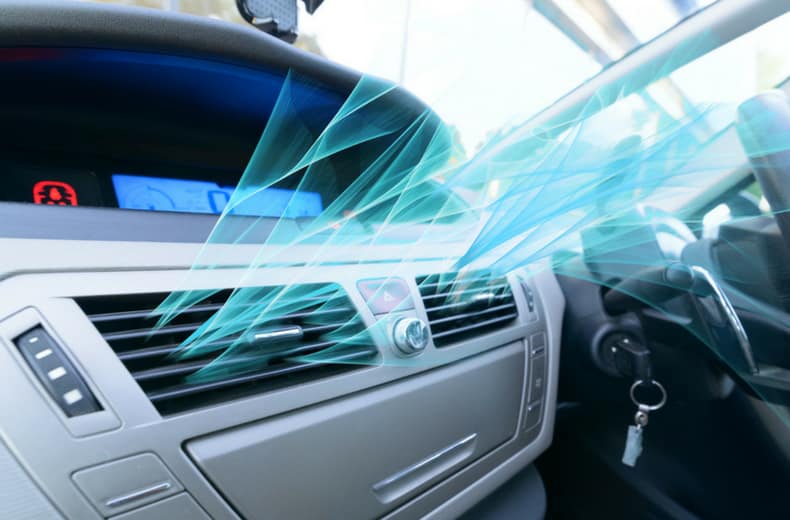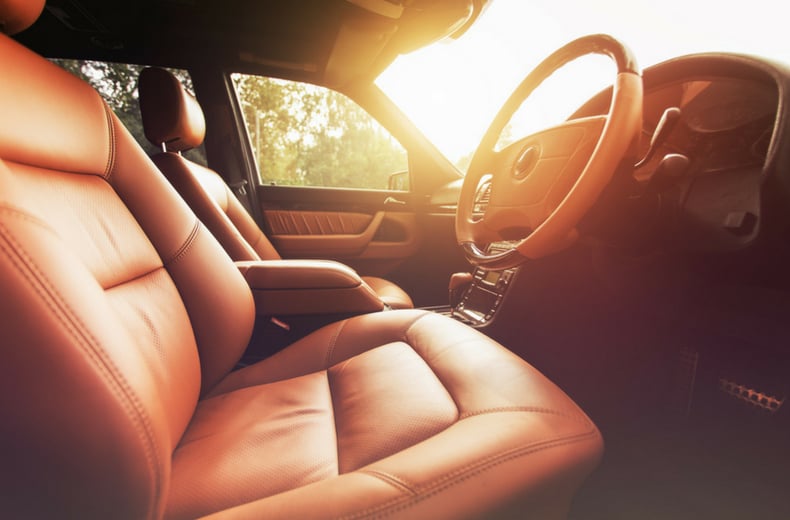Fortunately, there are some simple steps you can take to keep your car healthy and cool in the warm weather.
Follow our no-sweat guide to cooling down your hot car's interior. We'll also give you the car advice you need to perform some simple but essential summer car maintenance checks.
Top 5 tips to keeping your car cool in a heatwave
Park in the shade. This is a simple solution that's often overlooked by drivers. But keeping your car out of direct sunlight is one of the best ways to keep the interior cool in the summer
Cover the seats with a blanket or jacket. If your vehicle has leather seats then the summer sun will transform the surface of the seat into a hotplate. Keep them cool by covering them up, especially if you have to park in direct sunlight
Learn how to use your car's air conditioning system. Do you really understand how your vehicle’s air con or climate control system works? Check the owner’s manual to fully understand how it operates and what setting(s) you need to use to cool the car’s interior quickly and effectively in the summer
Carry water and soft drinks and all times. Keep a spare bottle of water and one or two soft drinks in your car at all times. Dehydration can impact your concentration and awareness levels, presenting a danger to drivers in hot weather conditions
Keep a cool bag/box in your car. This will keep drinks and snacks cool in a heatwave and ensure you can properly hydrate and have a refreshing, cool snack
How to cool down a hot car

1. Fan the interior
Open both the windows on one side of the car, then ‘fan’ the interior by swinging a door on the opposite side back and forth.
Providing you're not worried about potentially looking a bit weird, repeat this open-close motion at least three times to help expel the hot air.
Leave the sunroof shut if the car is parked outside in sunlight, though.
2. Switch on the air conditioning and use the system correctly
Start the engine and switch the air conditioning to its coldest setting.
If your car offers the option, select the ‘external’ air setting (the symbol on the switch usually shows an arrow entering the car), rather than air recirculation (a circular arrow).
The air outside the car will be cooler at this point. Open all remaining windows, as the air-con system will take a few minutes to become effective.
3. Use the lower air vents
Heat rises, so it makes sense to blast the cooler, air-conditioned air into the footwells, forcing the hot air already inside the car upwards and out of the open windows.
Shut off the upper vents on the dashboard and at the base of the windscreen so that the full flow of air into the car is directed upwards.
As the car begins to cool, slowly close the windows to ensure the cool air stays inside the cabin.

Cheaper than AA or we’ll beat by 20%^
• Roadside cover from £5.49 a month*
• We get to most breakdowns in 60 mins or less
• Our patrols fix 4/5 breakdowns on the spot

4. Keep the windows open
If your car doesn't have air con then keep the windows open to circulate air inside the cabin. You should also keep the fans switch on and set to the coolest setting to improve ventilation.
5. Close the windows and switch to recirculated air
When the air conditioning is blowing cold, close all the windows and switch to (pre-cooled) recirculated air.
You can now open the upper air vents and adjust the flow as required.
More advanced ‘climate control’ air-conditioning systems allow you to set and maintain a constant temperature within the car.
- Summer driving tips - how to avoid a summer breakdown
- The top 10 best road trips in the UK
- Road trips with kids - how to survive long trips with kids
Remember your car checks with Summer FORCES

Remember the acronym 'FORCES' and you'll go a long way to ensuring your car is ready for any long drive.
F is for FUEL
Ensure you have enough fuel for your journey. Cars use more fuel in heavy traffic and start/stop conditions which can be regular occurrences, especially in warm weather.
O is for OIL
To avoid engine damage and a potential breakdown, remember to check your oil level and top up when necessary to reduce the chances of overheating in traffic.
R is for RUBBER
Your tyres can tell you a lot about how your car is performing. If they aren’t wearing evenly, then tyre pressures may be mismatched or there could be a fault with the steering.
Check that all four tyres have at least 3mm of tread and are inflated to the correct pressure - this is vital to maintaining good grip in wet and even icy conditions. For everything you need to know about how to check your tyres you can read our how to check your tyres advice complete with short video.
Also take a look at your wiper blades to ensure they're clearing the screen effectively and that the rubber has not perished.
C is for COOLANT
This does a vital job in ensuring the engine runs at the right temperature. If it’s not between the ‘min’ and ‘max’ levels, this could be the sign of a problem so contact a good garage without delay.
E is for ELECTRICS
Your wipers will help keep your windscreen clear of bugs, and you’ll need your lights on during any heavy downpours. The electrics also control your indicators and windows, so check there are no problems.
S is for SCREENWASH
Top-up your windscreen washer fluid by using a good quality screenwash, nobody wants bugs and seagull poo all over their windscreen after a trip to the beach.
How to prevent your car getting hot in the first place

1. Park away from direct sunlight
Parking in the shade – perhaps under a tree or canopy – is one easy way to prevent your car heating up. If you have a garage, then use it. It will keep your car cool, clean and secure.
2. Use a windscreen sunshade
A windscreen sunshade keeps the sun’s rays away from your car interior – especially the touch-points, such as the steering wheel and gear lever. They are available from most car accessory shops; simply tuck the shade behind the sun visors when you park the car.
3. Leave windows (slightly) open
Leaving your windows slightly open allows air to circulate through the car – particularly as the hot air inside rises. However, if your car is parked outdoors, we don’t advise leaving more than a couple of centimetres gap between the top of the window and the door frame. You don’t want a potential thief to be able to reach inside. Likewise, activate your alarm while the car is parked.
4. Cover your seats
Leather seats can get uncomfortably hot and sticky – and may degrade and crack if regularly exposed to heat. Fitting light-coloured seat covers is one solution, or you could opt for lighter upholstery in the first place. As a temporary measure, a towel spread over the seat will help keep you cool.
5. Wipe down hot surfaces
On very hot days, the interior door handles, steering wheel, gear lever and handbrake may become painfully hot to touch. Wiping them over with a damp cloth will remedy this.
6. Keep the air-con maintained
Keeping the air conditioning system maintained is vital for cooling your car quickly and effectively. The refrigerant gas will usually become depleted over time, and belts may need tightening or replacing. Consult your car handbook and stick to the service schedule.
Car troubles?
Book a diagnostic test with us today. RAC Mobile Mechanics will check your car for faults, talk you through any repairs you might need, and give you a report for your records.












